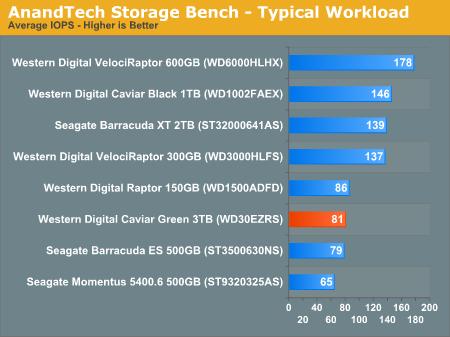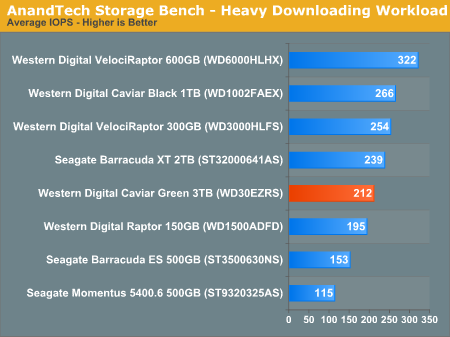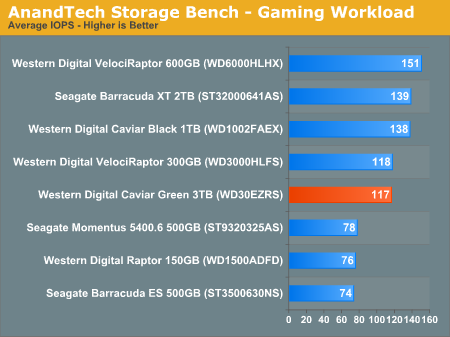Western Digital Caviar Green 3TB and My Book Essential 3TB Drives Reviewed
by Anand Lal Shimpi on October 19, 2010 1:43 PM EST- Posted in
- Storage
- HDDs
- Western Digital
- 3TB
AnandTech Storage Bench
The first in our benchmark suite is a light usage case. The Windows 7 system is loaded with Firefox, Office 2007 and Adobe Reader among other applications. With Firefox we browse web pages like Facebook, AnandTech, Digg and other sites. Outlook is also running and we use it to check emails, create and send a message with a PDF attachment. Adobe Reader is used to view some PDFs. Excel 2007 is used to create a spreadsheet, graphs and save the document. The same goes for Word 2007. We open and step through a presentation in PowerPoint 2007 received as an email attachment before saving it to the desktop. Finally we watch a bit of a Firefly episode in Windows Media Player 11.
There’s some level of multitasking going on here but it’s not unreasonable by any means. Generally the application tasks proceed linearly, with the exception of things like web browsing which may happen in between one of the other tasks.
The recording is played back on all of our drives here today. Remember that we’re isolating disk performance, all we’re doing is playing back every single disk access that happened in that ~5 minute period of usage. The light workload is composed of 37,501 reads and 20,268 writes. Over 30% of the IOs are 4KB, 11% are 16KB, 22% are 32KB and approximately 13% are 64KB in size. Less than 30% of the operations are absolutely sequential in nature. Average queue depth is 6.09 IOs.
The performance results are reported in average I/O Operations per Second (IOPS):

Real world drive performance is a bit of a letdown if you're planning on using the 3TB drive as a boot drive. It's barely any faster than an old Seagate Barracuda ES and even slower than the old 150GB VelociRaptor.
If there’s a light usage case there’s bound to be a heavy one. In this test we have Microsoft Security Essentials running in the background with real time virus scanning enabled. We also perform a quick scan in the middle of the test. Firefox, Outlook, Excel, Word and Powerpoint are all used the same as they were in the light test. We add Photoshop CS4 to the mix, opening a bunch of 12MP images, editing them, then saving them as highly compressed JPGs for web publishing. Windows 7’s picture viewer is used to view a bunch of pictures on the hard drive. We use 7-zip to create and extract .7z archives. Downloading is also prominently featured in our heavy test; we download large files from the Internet during portions of the benchmark, as well as use uTorrent to grab a couple of torrents. Some of the applications in use are installed during the benchmark, Windows updates are also installed. Towards the end of the test we launch World of Warcraft, play for a few minutes, then delete the folder. This test also takes into account all of the disk accesses that happen while the OS is booting.
The benchmark is 22 minutes long and it consists of 128,895 read operations and 72,411 write operations. Roughly 44% of all IOs were sequential. Approximately 30% of all accesses were 4KB in size, 12% were 16KB in size, 14% were 32KB and 20% were 64KB. Average queue depth was 3.59.

The more sequential the workload, the more the Caviar Green is going to behave like a normal high performance drive. In this case we're very close to the performance of Seagate's 7200RPM Barracuda XT 2GB (and presumably the upcoming 3TB version). The strong showing here is due to Western Digital's high areal density.
The gaming workload is made up of 75,206 read operations and only 4,592 write operations. Only 20% of the accesses are 4KB in size, nearly 40% are 64KB and 20% are 32KB. A whopping 69% of the IOs are sequential, meaning this is predominantly a sequential read benchmark. The average queue depth is 7.76 IOs.

Read performance is decent, but a good 7200RPM drive will still be a bit faster. The 3TB Caviar Green will serve as a good place to store movies, music and photos but if you're a gamer concerned about load times you might want to stick with a 7200RPM drive.










48 Comments
View All Comments
Photo-Nerd - Sunday, October 24, 2010 - link
It was slooooooooowwwwww, but on top of that, disk utility was reporting a smart failure.This drive equals the suck.
Boooooo
piroroadkill - Monday, October 25, 2010 - link
You mean that now and then you get failures of <any product name here>?Colour me shocked.
pesos - Saturday, December 18, 2010 - link
Hi Anand, I bought a mybook 3tb usb3 drive with the intention of using it to store Hyper-V VHD virtual disk files.Hyper-V is reporting that it cannot use drives with 4k sector sizes (way to go, microsoft). I have heard that the built-in WSB (same engine used for win7 backups) also has this limitation.
Do you know if there is any way to get 512b emulation on the MyBook drives, or do I need to return this drive and go with a different solution?
Thanks,
Wes
Azaloom - Monday, January 10, 2011 - link
That bundled PCIe-card really looks like a 4-port card. Maybe that's why the HighPoint’s drivers won't work - they have altered the card a little bit and removed port 3 and 4 plugs as excessive? But the solder bases looks to be there on the circuit board. I wonder if you could make it into a 4 four port SATA card just by soldering the missing SATA data-ports to their bases on the board. I mean I already thought about bying this HDD because I have all the SATA ports in use on my MB, and this would give the possibility of adding not one but two more HDD's - who knows, it that's four with a little tweaking. One PCIe lane should be more than enough to drive 4 mainstream HDD's for the average user.coyote2 - Tuesday, February 8, 2011 - link
If a 3TB drive is only formatted to < 2.19TB, would that remove all complications of booting from it?(Odd question, I know. But I'm buying a new system, for which I already own a boot drive I want to reinstall the OS onto; but the system builder requires that I buy the new system with the OS [Windows 7 Pro 64-bit] pre-installed; I'm just wondering if they only format a 3TB hdd to < 2.19TB, will booting from it will be issue-free?)
eazmichael - Tuesday, March 1, 2011 - link
Is WD using the same HD model in the 3TB My book as the internal package? The stand-alone drive costs around $215 or more while the 3 TB My book is now available for less than $180. i was thinking about putting two of the drives in a Synology DS211+ enclosure (Raid 1) - it looks a bit like it is cheaper to buy two My Books and rip the drives out.burbello - Monday, June 30, 2014 - link
Does anybody know if it is possible to replace the hard disk of Western Digital 640GB My Book for a new one with 3TB ? When replacing only the disk, should I perform any particular step? Thank you.burbello - Monday, June 30, 2014 - link
I have an Western Digital 640GB My Book, I would like to replace the hard disk to another WD 3TB, but I am not sure if it will work, does anybody know if this is compatible or even if I have to perform any additional step? Thank you